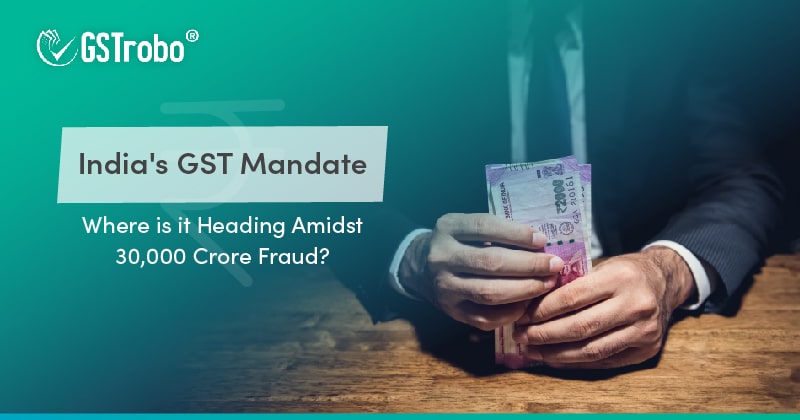India’s GST Mandate: Where is it Heading Amidst 30,000 Crore GST Fraud?
Tax evasion in a vast country like India has always been a point of concern, and the same reflects in the recent GST (Goods and Services Tax) evasion case of Rs 30,000 crores. While the Goods and Services Authority has diligently worked on unearthing such tax evasion frauds, but we as a country have a long way to go to eradicate and tackle the organized tax evasion rackets spread nationwide.

This article explores the path India is heading towards in its relentless pursuit to curb GST tax evasion and create a robust tax ecosystem.
The Menace of Tax Evasion
GST evasion, E-way billing, and e-invoicing frauds pose a significant threat to the economy, undermining fairness, transparency, and equity principles. It not only deprives the government of substantial revenue but also distorts the market by creating an uneven playing field for businesses. As the government takes measures to curb evasion, perpetrators employ sophisticated methods to circumvent the system.
There are ample GST fraud cases that have been encountered in the last few years to prove the status quo. In December 2022, the CBIC uncovered revenue swindles of Rs 62,000 crores with a total booking of 8,200 cases since the inception of the GST mandate in 2017.
Just recently, in June 2023, two massive cases of GST evasion came to light, one for Rs 10,000 crores in Noida and the other was a nationwide evasion drive by various state’s tax authorities for a total artifice of Rs 30,000 crores.
Over the years, India witnessed the following types of tax evasion –
- Shell companies,
- Obtaining GST registration based on fake addresses, documents, and fudged Aadhaar data,
- Bogus ITC (Input Tax Credit) claims,
- Counterfeit invoices,
- Listing erroneous deductions,
- Concealment of the assessable assets, among others.
Unveiling the Path Ahead: Tightening the Noose on GST Evasion
1. Encapsulating Technology
To curb tax evasion and detect patterns, identify anomalies, and predict potential cases of evasion, the government must embrace advanced technology like artificial intelligence, machine learning, and futuristic data analytics. This proactive approach enables authorities to intervene promptly, minimising revenue leakage and ensuring fair tax compliance.
2. Real-Time Compliance Monitoring
The government must actively explore the implementation of real-time compliance monitoring mechanisms. This includes using technology to track and monitor transactions in real-time, reducing the time gap for detecting non-compliance, and enabling swift corrective actions.
3. Collaboration with Industry Experts
Active collaboration between government and industry experts, tax professionals, and technology providers is necessary to identify gaps, address challenges, and refine the GST framework. This partnership can create a tax system that is responsive to the evolving needs of businesses while maintaining strict compliance standards.
4. Cemented Legal Framework
To deter potential offenders, India needs to introduce stricter penalties, including imprisonment and hefty fines. This also includes increased vigilance by authorities by conducting regular audits, inspections, and investigations around GST and e-invoicing. A robust framework of the e-way billing system can enhance transparency in the movement of goods and reduce the scope for evasion.
5. Cross-Verification and Collaboration
To comprehensively tackle the issue at hand, the GST authorities, income tax department, customs department, and financial intelligence units must bring improved transparency. This can be done through sharing data and conducting cross-verification to identify potential cases of tax evasion. This collaborative approach strengthens enforcement and increases the chances of detecting non-compliant entities.
The Road Ahead
GST in India is still a relevantly new reform with just 6 years in practice, and a streamlined and well-structured GST ecosystem in India is still a long journey. There is a lot the Indian government must incorporate within the system to avoid tax evasion and tax avoidance.
There is a need of a systemized tax and GST network to foster transparency, fairness, and compliance. The constant need to encourage active measures like
- Educating taxpayers with GST mandate,
- Informing customers about regular invoice demand,
- Single point of collection for major GST,
- Encourage the use of cash-less transactions,
- Simplifying tax rules and burdens,
- Inculcate third-party due diligence and loophole plugging.
Conclusion
India is moving steadily towards minimizing tax sidestepping and deceits, and ensuring a level playing field for all taxpayers has become the need of the hour. With continuous improvements and collective efforts, India is poised to establish a robust GST regime that benefits the economy, businesses, and citizens alike.
GST evasion is a pressing issue that needs the attention of not just the government but both businesses and citizens homogeneously. For all the economic sectors to thrive, it is imperative to reduce the cascading effect of tax evasion and the increasing number of fraudulent tax practices across the nation.
Only through cooperative collaboration across industries and strengthening education and awareness campaigns for the taxpayers can we battle the fight of combating GST evasion. By promoting a culture of tax compliance, we aim to build a society that stimulates the idea of an utmost sense of accountability, responsibility, and ownership.
